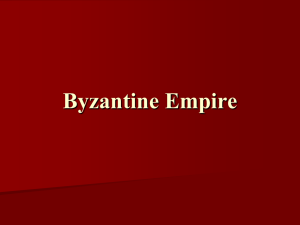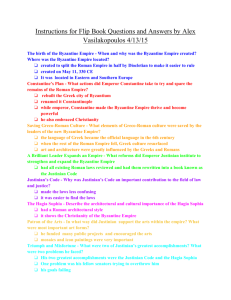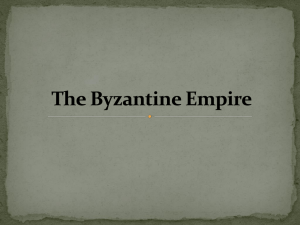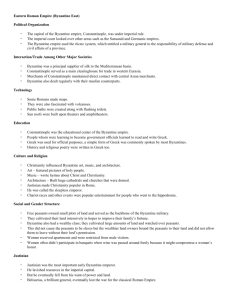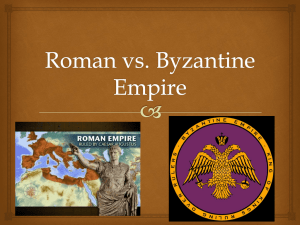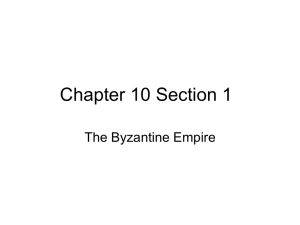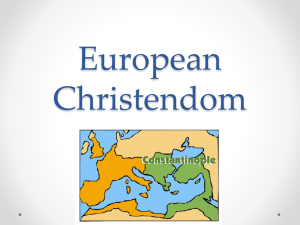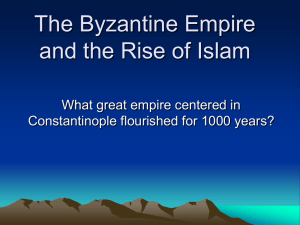Byzantine Empire
advertisement
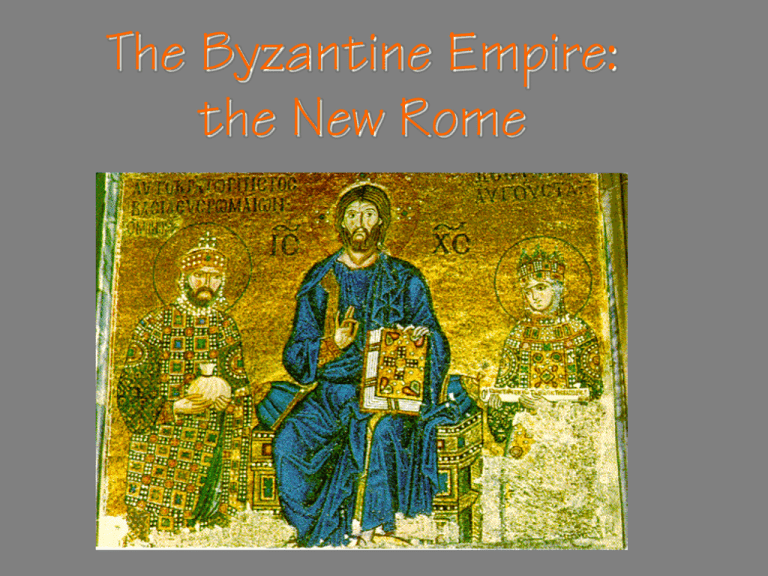
The Byzantine Empire: the New Rome Things to remember about the Byzantine Empire: rise and fall • • • • • • • • 312 CE: ____________ converts 333 CE capital of Rome moved to _________________ 476 CE Rome falls in the _______________ 527 J_____________n Rule 622 founding of _____________ 1054 Great _____________ 1071 Battle of Manzikerk where Seljek Turks defeat Byz 1453 Ottomans capture Constaninople And their “so whats” . . . .changes and continuities and why . Things to remember about the Byzantine Empire: geography The Roman Empire during the reigns of Leo I (east) and Majorian (west) in 460 AD. Roman rule in the west would last less than two more decades, whereas the territory of the east would remain static until the reconquests of Justinian I. The Byzantine Empire at the accession of Leo III, c. 717. Striped area indicates land raided by the Arabs At its greatest extent under _________ Constantinople falls to the Ottoman Turks in 1453A But hey it lasted over 1000 years! http://en.wikipedia.org/wiki/File:Byzantine_Empire_ani mated2.gif Constantine’s City--Constantinopolis (Constantinople) •Protection of the eastern frontier • Distance from Germanic invasions in the western empire • Crossroads of trade • Easily fortified site on a peninsula bordering natural harbor Barbarian Invasions of the Roman Empire Constantine’s Rule • Edict of Milan: established toleration for Christianity throughout the empire in 313 CE • The empire continued to be ruled by Roman law and political institutions, with the elite communicating officially in Latin. • Yet the population, now Christian, also spoke Greek. (lang of New Testament) art of the Early Byzantine period has from roots in Classical Greece and Rome seen in its naturalism and classical subject matter. The Beauty of Constantinople! • Constantine lavished on his new capital a university, 2 theaters, 8 public and 53 private baths, 52 covered walkways, 4 law courts, 14 churches, and 14 palaces. He imported staggering quantities of the best GrecoRoman art from throughout the empire. Sunset on the “Golden Horn” Constantinople: A Greek City (Istanbul today) --the new capital • Greco-Roman knowledge preserved in libraries Emperor Justinian [ruled 527-564 CE] Caesaropapism Icon depicting the Emperor Constantine (centre) and the bishops of the First Council of Nicaea The enlargement of the Eastern Roman Empire's territory between the rise to power of Justinian (red, 527) and his death (orange, 565) The expansion of existing empires—including China, the Byzantine Empire, and the Caliphates—as well as new empires—like the Mongols—facilitated trans-Eurasian trade and communication as new peoples were drawn into their conquerors’ economies and trade networks. Byzantine Trade Routes Merchants in Constantinople got quite wealthy through their control over the trade routes between Europe and the East and the shipping lanes connecting the Black and Mediterranean Seas. Byz. businessmen made more use than predecessors of ::: Justinian’s Empire at its Peak; “restoration” of the Empire Empress Theodora credited with influencing many reforms, including: expanded rights for women in divorce and property ownership, exposure of unwanted infants forbidden, and prohbitions against the killing of a wife who committed adultery . Justinian’s Code Studies, and then codifies Roman Law so you can know it today Corpus Juris Civilis Church of Hagia Sophia [Holy Wisdom] Interior of the Church of Hagia Sophia Imperial Administration The emperor was considered the representative of Christ by his subjects and he served as an absolute ruler. The emperor centered the government at his palace and had thousands of educated bureaucrats throughout the empire carrying out imperial legislation and operations, including the tax and justice systems. Look! A mosaic Theme System For administrative and military purposes; started in the 7th century Byzantine & Sassanid Empires, 6th c. War a Constant Contrast these maps and dates Icons Icon literally means image in Greek & came to be a definitive characteristic of Byzantine art. An icon was a depiction of a sacred person or scene which was treated as holy. Growing tension b/w Eastern And Western Christianity Iconoclastic controversy: West sees as appropriate aids to devotion; don’t like Byz saying otherwise the role of the emperor in matters of faith: in Western Europe, Pope was supreme in matters of faith ; The Byzantines, inherited the Roman idea that the emperor was near divinity and practiced a form of Christianity where enormous church and theological authority was vested in the emperor. Other diffs: Byzantine theology emphasized the divinity of Christ, the non-celibacy of priesthood, held services in vernacular instead of Latin) had beards, used unleavened bread, date of Easter Culminates in . . . . Schism in 1054 A permanent split in Christianity Byzantine Architecture Domes & arches Byzantine Mosaics Used glass mosaics which catch the light(Romans had used tiny stones) Highly decorative, symbolic, and flattened representations of Christian saints. The gold backgrounds are intended to give an heavenly atmosphere, and figures often have halos to represent their divine status. Occasionally, the Holy Roman Emperor or Empress are depicted, to show the unification of the church and state. Here, the Empress Theodora holds a goblet, representing the blood of Christ. Byzantine Art Influence of Byzantium on its Neighbors HOW? of trade routes linking the Baltic Sea and Black Sea. How: Grand Prince Vladimir of Kiev adopted Orthodoxy Christianity, and Kiev (early Russia; mix of Vikings and Slavs) spreads its influence to much of Eastern Europe.

